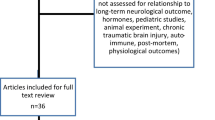Abstract
Background
Nitric oxide (NO) is a compound with both protective and damaging effects on neurons. Quantification of NO metabolites in humans is limited by sample contamination with blood. In vivo cerebral microdialysis may offer an alternative approach as sampling of extracellular fluid (ECF) adjacent to neurons becomes possible. We investigate the prognostic value of brain ECF NO metabolites in patients with traumatic brain injury (TBI).
Methods
A prospective case cohort of 195 ECF samples collected from 11 cases over 4 days following TBI was collected. Nitrate and nitrite concentrations ([NO x ]) were quantified using a vanadium-based colorimetric assay.
Results
Early ECF [NO x ] (<48 h post TBI) were significantly higher in non-survivors (median 59.2 μmol/l, n = 7) compared to survivors (23.3 μmol/l, n = 4) (P = 0.04). Late (48–96 h) ECF [NO x ] remained higher in non-survivors (47.9 μmol/l) compared to survivors (23.0 μmol/l) but this was not significant (P = 0.29). Receiver operator characteristic analysis shows an optimized cutoff level for ECF [NO x ] of 26.5 μmol/l measured <48 h post TBI for predicting non-survival (sensitivity 100%, specificity 75%).
Conclusion
Early ECF NO x concentrations are of prognostic value after TBI. ECF NO x may be a useful biomarker for treatment trials targeted at nitric oxide metabolism.


Similar content being viewed by others
References
Cherian L, Hlatky R, Robertson CS. Nitric oxide in traumatic brain injury. Brain Pathol. 2004;14:195–201.
Hlatky R, Goodman JC, Valadka AB, Robertson CS. Role of nitric oxide in cerebral blood flow abnormalities after traumatic brain injury. J Cereb Blood Flow Metab. 2003;23:582–8.
Moncada S, Bolanos JP. Nitric oxide, cell bioenergetics and neurodegeneration. J Neurochem. 2006;97:1676–89.
Rejdak K, Petzold A, Sharpe MA, et al. Cerebrospinal fluid nitrite/nitrate correlated with oxyhemoglobin and outcome in patients with subarachnoid hemorrhage. J Neurol Sci. 2004;219:71–6.
Clark RS, Kochanek PM, Obrist WD, et al. Cerebrospinal fluid and plasma nitrite and nitrate concentrations after head injury in humans. Crit Care Med. 1996;24:1243–51.
Uzan M, Tanriover N, Bozkus H, Gumustas K, Guzel O, Kuday C. Nitric oxide (NO) metabolism in the cerebrospinal fluid of patients with severe head injury. Inflammation as a possible cause of elevated NO metabolites. Surg Neurol. 2001;56:350–6.
Tisdall MM, Smith M. Cerebral microdialysis: research technique or clinical tool. Br J Anaesth. 2006;97:18–25.
Petzold A, Tisdall MM, Girbes AR, et al. In vivo monitoring of neuronal loss in traumatic brain injury: a microdialysis study. Brain. 2011;134:464–83.
Bellander BM, Cantais E, Enblad P, et al. Consensus meeting on microdialysis in neurointensive care. Intensive Care Med. 2004;30:2166–9.
Miranda KM, Espey MG, Wink DA. A rapid, simple spectrophotometric method for simultaneous detection of nitrate and nitrite. Nitric Oxide. 2001;5:62–71.
Hlatky R, Furuya Y, Valadka AB, Goodman JC, Robertson CS. Microdialysate nitrate/nitrite levels following severe head injury. Acta Neurochir Suppl. 2002;81:331–3.
Acknowledgment
MT is supported by a Wellcome Clinical Research Training Fellowship Grant, Grant No 075608. MS is partially funded by the Department of Health’s National Institute for Health Research Centres funding scheme via the UCLH/UCL Comprehensive Biomedical Research Centre.
Author information
Authors and Affiliations
Corresponding author
Rights and permissions
About this article
Cite this article
Tisdall, M.M., Rejdak, K., Kitchen, N.D. et al. The Prognostic Value of Brain Extracellular Fluid Nitric Oxide Metabolites After Traumatic Brain Injury. Neurocrit Care 19, 65–68 (2013). https://doi.org/10.1007/s12028-011-9633-5
Published:
Issue Date:
DOI: https://doi.org/10.1007/s12028-011-9633-5




